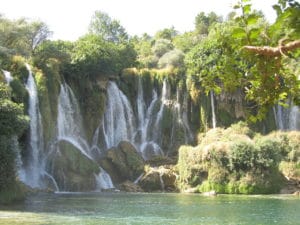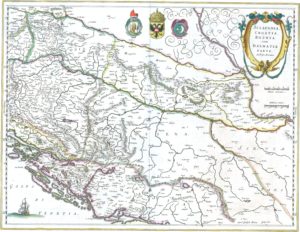
Bosnia and Herzegovina ranks highly in terms of human development, and has an economy dominated by the industry and agriculture sectors, followed by the tourism and service sectors. The country has a social security and universal healthcare system, and primary- and secondary-level education is tuition-free. It is a member of the UN, OSCE, Council of Europe, PfP, CEFTA, and a founding member of the Union for the Mediterranean upon its establishment in July 2008. The country is a potential candidate for membership to the European Union and has been a candidate for NATO membership since April 2010, when it received a Membership Action Plan.
Etymology:
The first preserved widely acknowledged mention of Bosnia is in De Administrando Imperio, a politico-geographical handbook written by the Byzantine emperor Constantine VII in the mid-10th century (between 948 and 952) describing the “small land” (χωρίον in Greek) of “Bosona” (Βοσώνα).
The name is believed to have derived from the hydronym of the river Bosna coursing through the Bosnian heartland. According to philologist Anton Mayer the name Bosna could derive from Illyrian *”Bass-an-as”), which would derive from the Proto-Indo-European root “bos” or “bogh”—meaning “the running water”. According to English medievalist William Miller the Slavic settlers in Bosnia “adapted the Latin designation Basante, to their own idiom by calling the stream Bosna and themselves Bosniaks”.
The name Herzegovina (“herzog’s [land]”, from German word for “duke”) originates from Bosnian magnate Stjepan Vukčić Kosača’s title, “Herceg (Herzog) of Hum and the Coast” (1448). Hum, formerly Zahumlje, was an early medieval principality that was conquered by the Bosnian Banate in the first half of the 14th century. The region was administered by the Ottomans as the Sanjak of Herzegovina (Hersek) within the Eyalet of Bosnia up until the formation of the short-lived Herzegovina Eyalet in the 1830s, which remerged in the 1850s, after which the entity became commonly known as Bosnia and Herzegovina.

On initial proclamation of independence in 1992, the country’s official name was the Republic of Bosnia and Herzegovina but following the 1995 Dayton Agreement and the new constitution that accompanied it the official name was changed to Bosnia and Herzegovina.
History:
Early History:
Bosnia has been inhabited by humans since at least the Neolithic age. The earliest Neolithic population became known in the Antiquity as the Illyrians. Celtic migrations in the 4th century BC were also notable. Concrete historical evidence for this period is scarce, but overall it appears the region was populated by a number of different people speaking distinct languages. Conflict between the Illyrians and Romans started in 229 BC, but Rome did not complete its annexation of the region until AD 9. It was precisely in modern-day Bosnia and Herzegovina that Rome fought one of the most difficult battles in its history since the Punic Wars, as described by the Roman historian Suetonius. This was the Roman campaign against Illyricum, known as Bellum Batonianum. The conflict arose after an attempt to recruit Illyrians, and a revolt spanned for four years (6–9 AD), after which they were subdued. In the Roman period, Latin-speaking settlers from the entire Roman Empire settled among the Illyrians, and Roman soldiers were encouraged to retire in the region.
